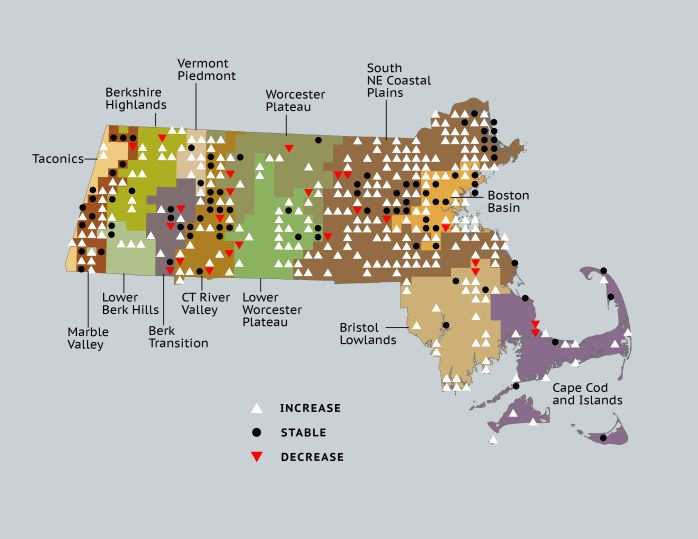Find a Bird
Willow Flycatcher
Empidonax traillii

Fairly widespread and strongly increasing
State Wildlife Action Plan listed
“Fitz-bew.” – Willow Flycatcher
Whereas their close relatives the Alder Flycatchers preferred to nest in the western reaches of the state during Atlas 1, Willow Flycatchers could be found in all parts of the Bay State. The initial expansion of Willow Flycatchers into Massachusetts may have brought them into conflict with their congeners, but as of Atlas 2 both Willow and Alder Flycatchers appear to be expanding species. Willow Flycatchers appear to predominate in low-lying areas with expansive moist second growth, such as overgrown wet meadows.
Historic Status
The bird we know today as the Willow Flycatcher was first noted in Massachusetts in the early 1930s, when it was believed to be a Traill's Flycatcher with a unique song-type, and lumped under the name Traill's Flycatcher along with the very-similar-looking Alder Flycatcher (Petersen & Meservey 2003). In reality, the Willow Flycatcher was a distinct southern and western species making a move northward and gradually displacing the Alder Flycatcher. The Willow Flycatcher moved into the state in greater numbers in the 1960s, just in time to confound Atlas workers conducting fieldwork for Atlas 1 (Petersen & Meservey 2003). In 1973, the American Ornithologists’ Union determined that the Alder and Willow Flycatcher were actually different species and split the Traill’s Flycatcher into the two species we know today.
Atlas 1 Distribution
Though identification challenges made the Willow Flycatcher’s historic status in the state somewhat murky, the species was definitively well established as a breeder by the time of Atlas 1. It was not unusual at that time to run into a Willow Flycatcher during the summer in the scrubby areas of the Marble Valleys, and the Connecticut River Valley had the largest number of occupied blocks of any region save for the much larger Coastal Plains. Although Willow Flycatchers were sparsely distributed across the Worcester Plateau, there were notable concentrations in the wetlands of the western and northeastern parts of the Coastal Plains. The Boston Basin also had an aggregation of Willow Flycatchers. The Bristol/Narragansett Lowlands and the Cape and Islands had only a small presence of breeding Willow Flycatchers in Atlas 1.
Atlas 2 Distribution and Change
Atlas 2: Like its close “cousin” the Alder Flycatcher, the Willow Flycatcher was increasing in every region of the state during Atlas 2. The distribution of these two species is instructive in attempting to understand the delicate niche partitioning that maintains them as separate populations – Willow Flycatchers are more rarely encountered in high-elevation regions such as the Berkshire Highlands and Worcester Plateau, while thriving in the lower elevation regions that Alder Flycatchers avoid such as the Connecticut River Valley. In the Coastal Plains in particular, there was a tremendous boom in Willow Flycatcher breeding activity, and this species has essentially surpassed the Least Flycatcher as the common breeding Empidonax in eastern Massachusetts. Willow Flycatchers were also found overall in 24 Boston Basin blocks from which they were formerly absent. Though they were sparsely distributed, Willow Flycatchers were present and Confirmed to be breeding in the Bristol/Narragansett Lowlands and Cape Cod.
Atlas 1 Map

Atlas 2 Map

Atlas Change Map

Ecoregion Data
Atlas 1 | Atlas 2 | Change | ||||||
Ecoregion | # Blocks | % Blocks | % of Range | # Blocks | % Blocks | % of Range | Change in # Blocks | Change in % Blocks |
Taconic Mountains | 1 | 6.3 | 0.8 | 4 | 16.0 | 0.9 | 2 | 13.3 |
Marble Valleys/Housatonic Valley | 13 | 33.3 | 10.7 | 29 | 74.4 | 6.7 | 16 | 41.0 |
Berkshire Highlands | 3 | 5.5 | 2.5 | 17 | 30.9 | 3.9 | 12 | 22.6 |
Lower Berkshire Hills | 2 | 7.1 | 1.6 | 7 | 22.6 | 1.6 | 5 | 18.5 |
Vermont Piedmont | 2 | 11.8 | 1.6 | 12 | 70.6 | 2.8 | 7 | 58.3 |
Berkshire Transition | 9 | 23.7 | 7.4 | 15 | 37.5 | 3.4 | 3 | 9.7 |
Connecticut River Valley | 21 | 37.5 | 17.2 | 43 | 66.2 | 9.9 | 14 | 29.2 |
Worcester Plateau | 5 | 6.4 | 4.1 | 19 | 21.6 | 4.4 | 8 | 16.7 |
Lower Worcester Plateau | 8 | 10.8 | 6.6 | 33 | 41.3 | 7.6 | 17 | 31.5 |
S. New England Coastal Plains and Hills | 32 | 11.9 | 26.2 | 173 | 61.1 | 39.7 | 107 | 47.3 |
Boston Basin | 13 | 23.2 | 10.7 | 37 | 66.1 | 8.5 | 23 | 41.8 |
Bristol and Narragansett Lowlands | 5 | 4.7 | 4.1 | 27 | 23.7 | 6.2 | 21 | 20.8 |
Cape Cod and Islands | 8 | 5.9 | 6.6 | 20 | 13.9 | 4.6 | 11 | 9.2 |
Statewide Total | 122 | 12.6 | 100.0 | 436 | 42.0 | 100.0 | 246 | 29.7 |
Notes
In accordance with Atlas increases, the Willow Flycatcher shows significant increasing Breeding Bird Survey trends in Massachusetts and in the New England/Mid-Atlantic Region.



